Introduction
- Books Name
- CBSE Class 6 Science Book
- Publication
- Param Publication
- Course
- CBSE Class 6
- Subject
- Science
Introduction
Suppose for some reason your family gets only one bucket of water everyday for a week. We would not be able to cook, clean utensils, wash clothes or bath and other activities. Apart from drinking, there are so many activities for which we use water.
We all depend on the same vital substance water, diverse by its nature, it is solid, vapour and liquid. It is in the air, on the earth surface and within the ground ever-changing and giving shape to a dramatic range of natural ecosystems.
For the earth’s inhabitants, diversity of the resource also means great disparities in well being and development . As we degrade the quality of our water and modify the natural ecosystems on which people and life depend, we also threaten our own survival.
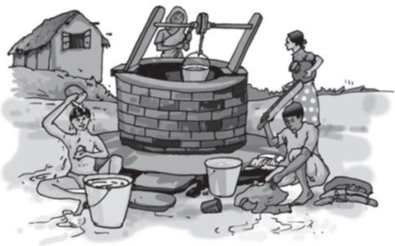
Uses of water
How much water do we use?
- Books Name
- CBSE Class 6 Science Book
- Publication
- Param Publication
- Course
- CBSE Class 6
- Subject
- Science
Availability of water
Water is the most widely occurring substance on this planet. Globally distributed by the hydrological cycle, driven by the energy cycle, the circulation of water powers most of the other natural cycles and conditions the weather and climate. Water has shaped the earth’s evolution and continues to fashion its programmes. This is the water precipitated from the atmosphere on to land, where it may be stored in liquid or solid form, and can move laterally and vertically and between one phase and another phase by evaporation , condensation , freezing and thawing on the land surface. This water can travel at widely differing velocities usually by predictable pathway’s which can slowly change with time. We are aware that about 71% of the earth’s surface is covered with water. Almost all the water on the earth is contained in the seas and oceans, rivers , lakes, ice caps, as groundwater and in the atmosphere. However, most of this water is not fit for human consumption.
Where do we get water from?
- Books Name
- CBSE Class 6 Science Book
- Publication
- Param Publication
- Course
- CBSE Class 6
- Subject
- Science
Rainwater Harvesting
(i) Water harvesting is the activity of collection of rainwater directly by various means.
(ii) Harvested water can either be used immediately or it can be stored for later use.
(iii) In Kerala and Mizoram, where it rains almost the whole year round, small tanks are used to collect rainwater, which drains from rooftops through pipes into these tanks. This water is used directly.
(iv) In a place like Delhi where the monsoon lasts only for 3 months, it is more useful to collect rainwater as groundwater.
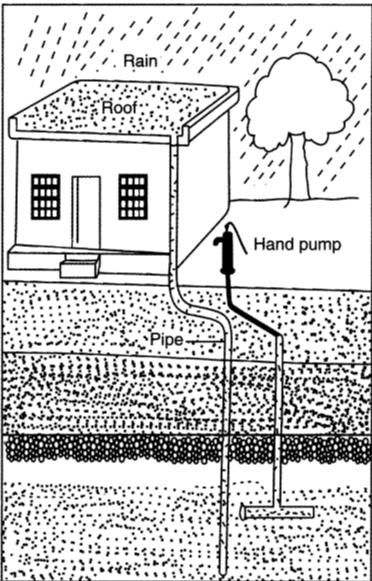
Water cycle
- Books Name
- CBSE Class 6 Science Book
- Publication
- Param Publication
- Course
- CBSE Class 6
- Subject
- Science
Water Conservation
(i) It is very important that water should be used carefully. We should take care that water should not get wasted.
(ii) It is not necessary that the water used in the garden is fit for drinking. Yet most often we water the gardens with drinking water supplied by the corporation. We should use water for gardening that has already been used in the kitchen for washing vegetables and fruits, etc.
(iii) Always be careful that the water tank in your house doesn't overflow when it is being filled.
(iv) Don't use a hose pipe to wash your car or scooter. Use a bucket instead.
(v) If you leave the tap running while brushing your teeth, about 16 litres of water gets used up. Fill a mug with water and use instead.
Back to the oceans
- Books Name
- CBSE Class 6 Science Book
- Publication
- Param Publication
- Course
- CBSE Class 6
- Subject
- Science
Sources of Water
(i) Rivers and springs : Most of the water which human beings use for drinking, washing and farming comes from rivers and springs. The river flows down the mountain side and across the land, finally flowing into a sea or an ocean.
(ii) Oceans and seas: Most of the water on the earth is found in the oceans and seas. However, the water found in the oceans and seas is not fit for drinking or agricultural purposes as it contains large amount of salt. However, ocean acts as a habitat for large number of plants and animals.
(iii) Snow : Some regions of the earth are covered with snow especially during winters. Water formed by melting of snow is another source of water. This snow melts slowly. Sometimes this water flows down in the form of streams and rivers. Streams and rivers are another sources of water.
(iv) Groundwater : The ground water is actually rainwater which mainly comes from seepage of water accumulated under the ground. Figure shows the accumulation of groundwater.
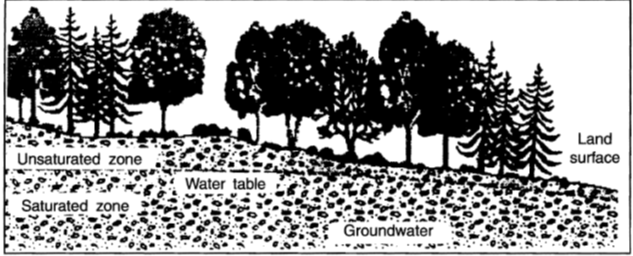
(v) Water table: If you take soil from ground, it has air as well as water. As you go down, the amount of water increases and air decreases. A level below surface, where it is only water is called the water table.
(vi) Lakes and ponds: These are small reservoirs of water. These are created by collection of rainwater in low lying areas. Seepage from the groundwater reserves also adds to the water in lakes and ponds.
(vii) Rain: The rain is a very important source of water for us. All resources of water are fed mainly by rains.
What if it rains heavily?
- Books Name
- CBSE Class 6 Science Book
- Publication
- Param Publication
- Course
- CBSE Class 6
- Subject
- Science
Natural Calamities
(a) Drought : If it does not rain for a year or more at a place, the soil will lose its water by evaporation and becomes dry. Water will also be lost through transpiration process from the plants. Rivers, ponds and wells will dry and the water table would lower down. All this will affect the humans, animals and wild plants. If it continues for one or two years consecutively, it results into drought.
Consequences of drought : The result of drought may be no crops. The availability of food and fodder will decrease. The overall consequence of such a situation will lead to loss of life of humans and animals.
(b) Flood : In case of continuous rains, the water level of rivers, lakes and ponds will rise. The soil surface will get laden with water resulting into flood.
Consequences of flood : When the soil gets too much of water, air in the soil comes out of it. Due to lack of air, the animals living inside the soil also come out of it. Heavy rainfall also results in the loss of crops due to flood.
Factors responsible for flood : A numbers of factors are responsible for flood. These factors can be intensity and duration of rainfall, soil condition and presence of plants or trees on the ground.
What happens if it does not rain for a long period?
- Books Name
- CBSE Class 6 Science Book
- Publication
- Param Publication
- Course
- CBSE Class 6
- Subject
- Science
4. Water Back to Ocean :
The water that falls on the land as rain and snow sooner or later goes back to oceans. This may happen in many ways.
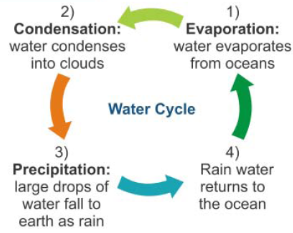
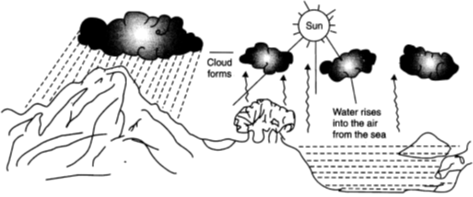
Cloud formation
Cloud formation :
• When the air moves up, it gets cooler and cooler.
• At sufficient heights, the air becomes so cool that the water vapor present in it condenses to form tiny drops of water called droplets.
• It is these tiny droplets that remain floating in air and appear to us as clouds.
How can we conserve water?
- Books Name
- CBSE Class 6 Science Book
- Publication
- Param Publication
- Course
- CBSE Class 6
- Subject
- Science
Water cycle
It is circulation of water through the process of evaporation or condensation as rain or snowfall. Water cycle is like a ring. In nature, the water cycle takes place from sea to land and back to sea again.
1. Loss of water by evaporation
• During the daytime, sunlight falls on the water in oceans, rivers, lakes and ponds.
• As a result, water from all these places continuously evaporates into vapour.
• However, the salts dissolved in the water are left behind.
2. Loss of water by transpiration
• Plants need water to grow.
• A part of this water is used to make food and another is retained in different parts of the plants.
• Remaining part of this water is released by the plants into air, as water vapour through the process of transpiration.
3. Formation of water by condensation
• Condensation plays an important role in bringing water back to the surface of the earth.
• As we go higher from the surface of the earth, it gets cooler. When the air moves up, it gets cooler and cooler.
• At sufficient heights, the air becomes so cool that the water vapour present in it condenses to form tiny drops of water called droplets.
• It is these tiny droplets that remain floating in air and appear to us as clouds.
• Many droplets of water come together to form larger sized drops of water.
• Some drops of water become so heavy that they begin to fall as rain.
Thus, water in the form of vapour goes into air by evaporation and transpiration, form clouds, and then comes back to the ground as rain, hail or snow.
Most of the water fall on the earth as rain.
Rainwater harvesting
- Books Name
- CBSE Class 6 Science Book
- Publication
- Param Publication
- Course
- CBSE Class 6
- Subject
- Science
Three states of Water
Water can exist in all the three states-solid, liquid and gas.
(i) Liquid state: The water that we use in everyday life is a liquid. It is called liquid state of water.
(ii) Gaseous state: We have learnt that on heating, water evaporates to form its vapour. Water vapour is its gaseous state.
(iii) Solid state: Water turns into ice on cooling. Ice is the solid form of water.
These three states of water are interconvertible to each other, that is, we can change it from one state to another.

Interchangeability of states of matter
• Melting : Change of substance from solid state to liquid state.
• Evaporation or boiling: Change of substance from liquid state to gaseous state.
• Transpiration : It is the evaporation of water into the atmosphere from the leaves and stems of plants.
• Condensation : Change of substance from gaseous state to liquid state.
• Freezing or solidification: Change of substance from liquid state to solid state.
9
- Books Name
- CBSE Class 6 Science Book
- Publication
- Param Publication
- Course
- CBSE Class 6
- Subject
- Science
Uses of Water
(i) It is needed for drinking, bathing, washing, cleaning of vessels, toilets, flushing, etc.
(ii) Our body contains about 70 percent of water. Therefore, water is essential for our life.
(iii) Water helps animals and plants to cool.
(iv) Water is essential for the germination of seeds.
(v) Water is required for irrigation of the crops.
(vi) Water is used to generate electricity.
(vii) Water wheel is used to run flour mills.
(viii) Water is used in many industries, like paper, rayon, petroleum refining, fertilizers, dyes, drugs and other chemical industries.
(ix) Water is used in car radiators to keep the engine cool.
(x) In cold countries, people use water to warm their houses.
(xi) Water is used to keep the things cool.
KEY WORDS
1. Clouds : When water vapour goes up where temperature is low it gets condensed into tiny water droplets and forms clouds.
2. Condensation : The process of conversion of vapour into liquid form of water is called condensation.
3. Drought : A prolonged period of abnormally low rainfall, leading to a shortage of water.
4. Evaporation : Process of conversion of water into water vapour is called evaporation.
5. Flood : In case of continuous rains for long time at a place, it will result into the rise in the water level of rivers, lakes and ponds. The soil surface will get laden with water resulting into flood.
6. Groundwater : The groundwater is actually rainwater which mainly comes from seepage of water, accumulated under the ground.
7. Hail :Sometimes during precipitation of water droplets, water freezes, and takes the form of hail
8. Ocean : Ocean is the biggest body of water surrounding the globe.
9. Rainwater harvesting : Rainwater harvesting is the activity of collection of rainwater by various means.
10. Snow : It is the condition similar to the formation of hail.
11. Water vapour : Water exists in three forms–solid, liquid and gas. Gaseous form of the water is called water vapour.
12. Water cycle : The circulation of water through the process of evaporation and rain or snowfall.

 Param Publication
Param Publication
 PathSet Publications
PathSet Publications
